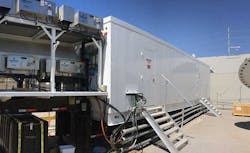Survey Shows Steps Toward Sustainability, Standardization at the Edge
To dig deeper into how organizations were planning for and managing this growth, Vertiv recently conducted a What’s Your Edge global survey.
On average, 21% of participants’ IT infrastructure is currently deployed at the edge. In five years, they expect that to increase to 27%. That’s nearly a 30% increase, which represents a significant shift in overall resources to the edge, confirming what the industry is feeling. Furthermore, while 41% of participants were supporting legacy edge sites, 59% had already deployed or were planning to deploy purpose-built edge sites.
One of the goals of the survey was to identify the characteristics of the edge sites companies are supporting and deploying today, and looking at purpose-built sites was of particular interest since the boundaries of legacy space and technologies are removed.
Enterprise values are coming to the Edge
While sustainability has long been gaining traction in enterprise data centers, the survey showed that commitment was extending to the edge. Of those purpose-built sites, more than three-quarters (77%) are using or planning to use energy-efficient uninterruptible power supply (UPS) systems, while 40% are planning to use renewable energy and 31% are planning to adopt some form of water efficient cooling. Nearly 30% are planning to use dynamic grid support technologies, and 19% will choose refrigerants based on low global warming potential.
Also mirroring core sites, security and availability were top challenges participants identified in designing and deploying edge sites. Design and management practices, however, did not always support these goals. For instance, only 39% of participants used dedicated precision cooling to deal with the heat generated by edge sites, even though more than 90% of sites are consuming at least 2 kilowatts (kW) of power — a threshold at which dedicated cooling is recommended.
Integrated Solutions Gain Steam
While there is currently a gap between desired Edge resiliency levels and some design and management practices, organizations are adopting strategies that will enable them to close these gaps, most notably the move toward integrated infrastructure systems.
Forty percent of participants were using or planning to use integrated rack solutions, or micro data centers, and an additional 20% were using or planning to use prefabricated modular data center systems.
These solutions can help improve availability while speeding the deployment of new Edge sites, when specified to arrive on-site IT-ready, with power, cooling, and management technologies fully integrated based on the workload, availability, and environmental requirements of the application.
Standardization Can Help
The report Archetypes 2.0 deployment-ready Edge infrastructure models defines four edge computing models, ranging from the device-level edge to regional edge data centers. Determining your model can provide some level of standardization to simplify new deployments.
Using the models defined in the Archetypes 2.0 report, the most common edge deployments today, based on the survey, fall within the Micro Edge model — up to four equipment racks deployed at an enterprise site such as a retail store, factory floor, or network closet. Half of the participants were supporting or planning edge sites that fit this model.
Martin Olsen is VP Global Edge & Integrated Solutions at Vertiv. Read more about the current and future state of edge of network by visiting the full survey report.


